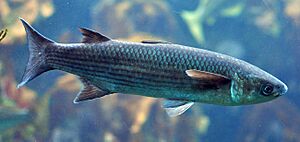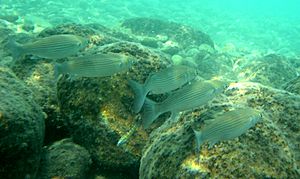Leaping mullet facts for kids
Quick facts for kids Leaping mullet |
|
|---|---|
 |
|
| Conservation status | |
| Scientific classification | |
| Synonyms | |
|
The leaping mullet (Chelon saliens) is a type of fish that lives in coastal waters and estuaries (where rivers meet the sea). It belongs to the Mugilidae family, also known as the mullet family. You can find this fish in the northeast Atlantic Ocean, from Morocco to France. It also lives in the Mediterranean Sea and the Black Sea. This fish was even introduced to the Caspian Sea and now lives there too!
About the Leaping Mullet
The leaping mullet has a cool look. Its back is a greyish-brown color, and its belly is shiny silver. It often has golden reflections on its sides. The fins of this fish are a pretty orangish-brown color.
Where Leaping Mullets Live
The leaping mullet lives in shallow areas along the coast. You can find it in the northeastern Atlantic Ocean, reaching as far north as the Bay of Biscay. It also swims in the warm waters of the Mediterranean Sea. This fish is also common in the Black Sea and the Sea of Azov. In the 1930s, some leaping mullets were moved to the Caspian Sea. They have done very well there and are now a regular part of the fish population.
Life Cycle and Diet
The leaping mullet lays its eggs during the summer months. A female can produce between 500 and 2,000 eggs. The eggs are fertilized outside the female's body. These eggs float freely in the water, which means they are pelagic. Each egg has a large oil drop inside it.
When the eggs hatch, the tiny baby fish are called fry. These fry get their first food from a special yolk sac attached to them. They grow very quickly! As they get a bit bigger, the young fish start to eat tiny floating animals called zooplankton. Later, they switch to eating small creatures that live on the bottom of the sea, which are called benthic organisms.
Male leaping mullets are ready to have their own babies when they are about three years old. Females take a bit longer, becoming mature at around four years old. Adult leaping mullets are detritivores. This means they mostly eat detritus, which is decaying plant and animal matter. They also eat sand, along with algae and other plant material they find.



